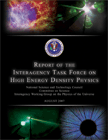| High
Energy Physics (HEP)
The mission of the High Energy
Physics (HEP) program is to explore and to discover
the laws of nature as they apply to the basic
constituents of matter, and the forces between
them. The core of the mission centers on investigations
of elementary particles and their interactions,
thereby underpinning and advancing Department
of Energy missions and objectives
through the development of key cutting-edge
technologies and trained manpower that provide
unique support to these missions.
HEP Program
Highlights (149k PDF)
High
Energy Physics Advisory Panel (HEPAP)
HEP
Staff
HEP Quick Links
· Fermilab
Research
· Large
Hadron Collider
· International
Linear Collider (ILC)
 |
High Energy Density
Physics
August 2007 Report of the Interagency Task Force on High Energy Density
Physics, as requested by the Interagency Working Group on the Physics of the Universe, Committee on Science, National Science and Technology Council more> |
 |
symmetry:
dimensions of particle physics
A joint Fermilab/SLAC publication |
Communication resource from the world's particle
physics laboratories

Special Feature
From the December 2002-January
2003 issue of The Industrial Physicist:
Will
innovation flourish in the future?
- Jerome I. Friedman
In modern industrial nations,
quantum mechanics contributed to the Internet,
computers, lasers, atomic clocks, the Global
Positioning System, and superconductors. But
who is going to do the basic research that will
form the basis for the next technology revolutions?
From
the December 2002-January 2003 issue of The
Industrial Physicist. This article is copyright
American Institute of Physics and may be downloaded
for personal use only. Any other use requires
prior permission of the author and the American
Institute of Physics.
|